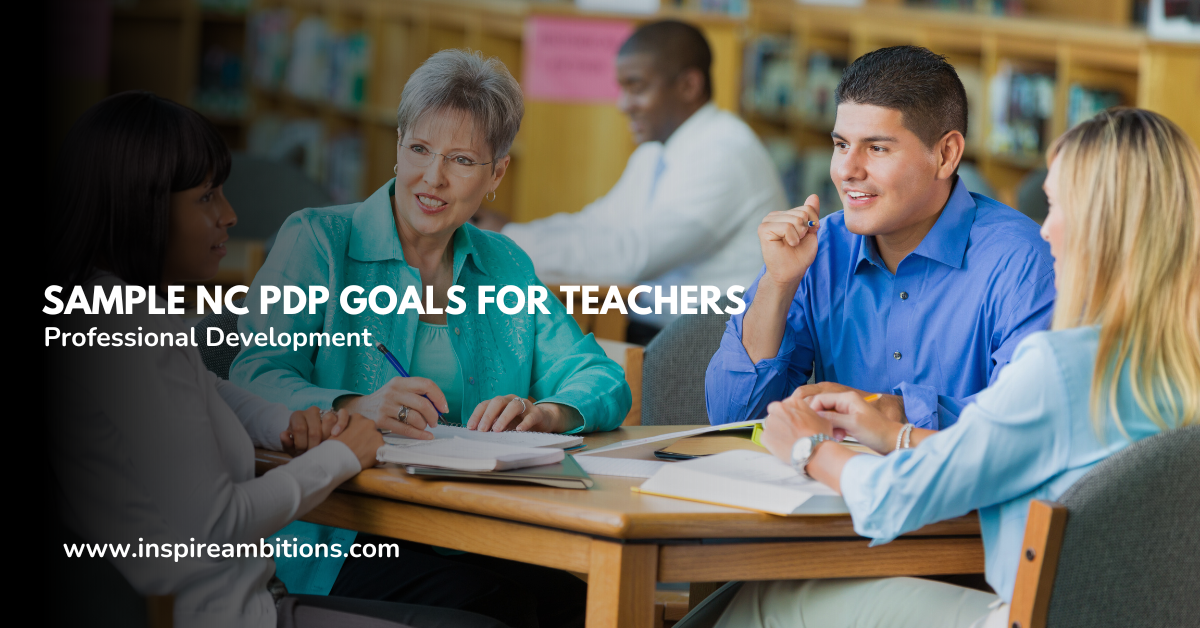শিক্ষকদের জন্য নমুনা NC PDP লক্ষ্য – কার্যকরী পেশাগত উন্নয়নের কৌশল
Crafting a roadmap for success as an educator within North Carolina’s school system requires a well-thought-out Professional Development Plan (PDP).
Tailored to individual aspirations and the district’s educational goals, PDPs are a focused strategy for teachers to enhance their skills and advance their careers.

For many teachers, creating a PDP is not just a formal requirement but a valuable tool for measuring progress and pinpointing areas for personal and professional growth.
দ্বারা setting realistic and strategic goals, teachers can prioritize their development efforts in alignment with their students’ needs and those of their students, all within the supportive structure of the district’s resources.
Sample NC PDP Goals for Teachers – Key Takeaways
- Professional Development Plans are essential for goal-setting and teacher progress.
- Strategies for implementing PDPs are crucial for actualizing teaching aspirations.
- Continuous assessment and access to support optimize the PDP’s effectiveness.
Professional Development Plan Creation

When crafting your Professional Development Plan (PDP), it’s imperative to pinpoint your কর্মজীবন লক্ষ্য and ensure they align with your district’s standards. This strategic blueprint is your roadmap for professional growth within the education sector.
Identifying Career Goals
Knowing where you want your teaching career to head is the cornerstone of your PDP. Begin by asking yourself what your endgame is. Do you aim to specialize in a particular subject or grade level? Perhaps you’re inclined toward educational leadership or policy development. Reflect on where you see yourself shortly and jot down these ambitions in a goal-oriented table.
| Short-Term Goals | Long-Term Goals |
|---|---|
| Gain proficiency in a new teaching method. | Transition into an instructional leadership role. |
| Attend a workshop on special education needs. | Obtain a master’s degree in education administration. |
Aligning with District Standards
Next, map your career objectives to the standards and needs of your district. Scrutinize your district’s initiatives and expectations for teachers. Are they focusing on technology integration or small-group instruction effectiveness?
Your goals should not only advance your professional skills but also be of value to your district. Cross-reference your ambitions with district priorities, creating a synchronized list that promotes mutual growth.
| Your Goals | District Priorities | Alignment Action |
|---|---|---|
| Integrate educational technology in the classroom. | Increase digital literacy among students. | Implement tech-based lesson plans and seek PD on digital tools. |
| Foster an inclusive classroom environment. | Enhance diversity training for staff. | Lead a PD session on inclusivity and attend related seminars. |
By adhering to these focused strategies, you’ll be well on developing a comprehensive PDP that reflects your personal aspirations and your district’s framework for success.
Implementation Strategies for Sample NC PDP Goals

As you develop your Professional Development Plan (PDP), focusing on the implementation strategies is crucial. These strategies will position you to harness technology, explore effective teaching methodologies, and engage in collaborative growth.
Leveraging Technology for Learning
Embrace tech tools that elevate your teaching. For example, integrating a Learning Management System (LMS) can streamline content delivery and enhance student engagement. Use platforms like Google Classroom to assign and assess work efficiently.
Effective Teaching Methods
Stay abreast of best practices in pedagogy, ensuring that your instructional design is rooted in research-proven strategies. Incorporate methods like differentiated instruction to cater to diverse learning needs, and consistently use student data to inform your teaching.
Collaborative Professional Growth
সহযোগিতা among peers is a cornerstone of professional development. Actively participate in Professional Learning Communities (PLCs) where you can share insights and strategies, refining your practice through reflective dialogue and collective inquiry.
When aiming for excellence in teaching, assessing performance and leveraging feedback are crucial. Armed with the right tools and mindset, you can transform these evaluations into stepping stones for professional growth.
Utilizing Observations and Feedback
Observations play a vital role in gauging teacher performance. They offer tangible insights into your instructional strategies and classroom management skills. To capitalize on these observations, actively seek feedback from peers and administrators.
This feedback should provide specific examples of strengths and areas for improvement. For instance, it may highlight your interactive teaching methods or suggest enhancing student engagement during lessons.
Self-Reflection and Rubric Use
Self-reflection is a powerful mechanism that enables you to examine your teaching practices critically. Pair this with a rubric, a detailed framework outlining desired teaching competencies. Regular rubric-guided self-assessments can help chart progress, identify goals, and shape your Professional Development Plan (PDP) objectives.
Consider the North Carolina Professional Teaching Standards as a reference point, evaluating leadership, data use, and ability to establish a safe and orderly environment.
Support and Resources
As you commit to your professional growth, understanding the support and resources available can make a substantial difference in the success of your personal development plan.
Accessing Professional Development Funding
Identifying sources of funding is a critical step towards advancing your professional development. In North Carolina, you may find financial support for কর্মশালা and seminars designed to enhance your teaching skills. Be sure to investigate state-funded opportunities or grants that target educators looking to improve their classroom effectiveness and pedagogical strategies.
Continuous Learning Opportunities
Engaging in continuing professional development ensures that you stay at the forefront of educational best practices. Look for continuous learning opportunities that align with your Personal Development Plan. This might include local or online courses, peer-learning workshops, or collaborative projects with colleagues that will contribute to your goals and benefit your students’ learning experiences.







